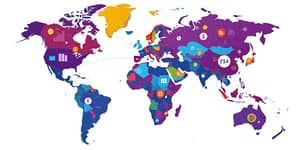
In recent years, the internet has undergone a remarkable transformation. From the static pages of Web1 to the dynamic, social-driven platforms of Web2, each phase has redefined the way we connect, share, and create. Today, we stand on the cusp of a new era—Web3—a paradigm shift that promises to redistribute power to the user and foster a more equitable digital landscape.
By integrating decentralized architectures, blockchain, and smart contracts, Web3 offers an internet where user ownership and autonomy are built into the very fabric of online interaction. This article explores the core concepts, market dynamics, industry impacts, technical innovations, and future prospects of Web3, inspiring you to embrace and navigate this transformative landscape.
At its essence, Web3 is defined by three foundational pillars that work in concert to create a more transparent, secure, and user-centric online environment. Unlike Web2, which relies on centralized servers controlled by large corporations, Web3 harnesses peer-to-peer networks and blockchain technology to ensure that no single entity can exert undue influence.
In addition to these pillars, Web3 often integrates artificial intelligence, semantic web technologies, and immersive 3D and spatial web capabilities to deliver richer and more meaningful online experiences.
One of the most compelling distinctions between Web2 and Web3 lies in how data is governed and secured. Traditional web platforms have built sprawling data silos, harvesting user information for targeted advertising and centralized decision-making. Web3, by contrast, empowers individuals through distributed networks and smart contracts that automate trust and eliminate intermediaries.
By shifting control to users, Web3 not only enhances security but also fosters a culture of collaboration and shared governance.
The global Web3 market is experiencing unprecedented expansion. In 2024, estimates placed its value between USD 3.17 and 4.62 billion, with forecasts predicting it will reach USD 6.15 billion by 2025 and surge to nearly USD 99.75 billion by 2034 at a CAGR of 41.18%.
This momentum is driven by innovations in decentralized finance (DeFi), non-fungible tokens (NFTs), and the metaverse—virtual worlds built on context-aware and user-intent-driven interactions. As more individuals and institutions recognize the potential for creating, trading, and governing digital assets without intermediaries, adoption continues to accelerate across sectors.
By 2025, Web3 is poised to become as fundamental as email or online shopping. Its impact spans multiple verticals:
These innovations are not theoretical—they are already reshaping how people work, socialize, and earn online, offering a glimpse of a more inclusive digital future.
Web3’s ambitious vision rests on cutting-edge technologies. However, widespread adoption demands solutions to several critical challenges.
While decentralization inherently bolsters security, it also introduces new attack vectors. As Web3 matures, robust auditing, formal verification of smart contracts, and advanced privacy-preserving techniques become indispensable.
Governments and financial institutions worldwide are racing to establish frameworks that support innovation while protecting consumers. Emerging regulations focus on taxation of cryptocurrencies, compliance for DeFi platforms, and anti-money laundering controls for NFTs.
Regulatory clarity fuels mainstream adoption by reducing uncertainty. As legal frameworks evolve, organizations can build compliant solutions that integrate seamlessly with both traditional and decentralized financial infrastructures.
Ultimately, Web3 is more than a technological upgrade—it is a movement towards greater agency, transparency, and inclusivity on the internet. By redefining trust through code, it empowers everyone to become an active stakeholder rather than a passive consumer.
The promise of a truly decentralized web invites us to reimagine how we collaborate, innovate, and govern online. As you explore this dynamic landscape, remember that the future of the internet lies in collective empowerment—and each of us has a role to play in shaping it.
Now is the time to dive in: contribute to open-source projects, explore decentralized platforms, or simply educate yourself about the emerging tools that will define tomorrow’s digital interactions. Together, we can build a web where trust is code, ownership is transparent, and creativity knows no bounds.
References













